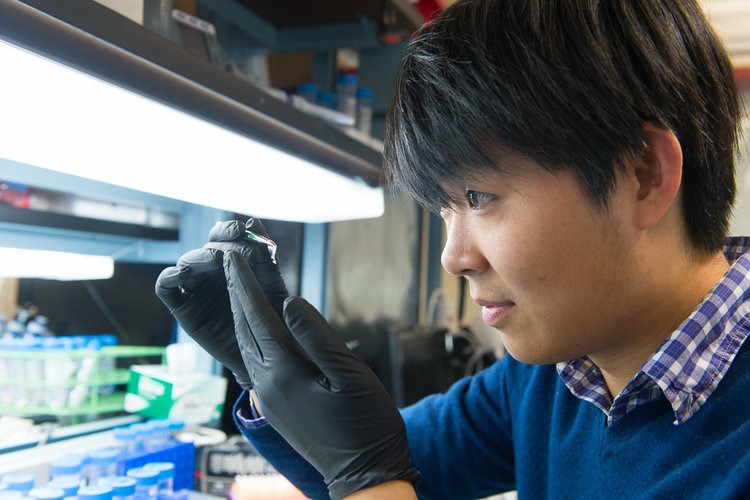Fei Chen, Microscopy Maven
Ever since 17th-century Dutch scientific pioneer Antonie van Leeuwenhoek used his primitive microscope to peer at a drop of lake water and discover bacteria, scientists have worked to improve microscopes to see finer and finer features in biological samples.
Fei Chen, a Schmidt Fellow at the Broad Institute, has now stood the paradigm on its head. His idea: To see smaller features, make the samples bigger!
Chen, who earned his Ph.D. at MIT in 2016, develops new tools to provide clearer snapshots of cellular and subcellular dynamics. While at MIT, he co-invented expansion microscopy, a technique that literally expands specimens—thanks to swellable polymers similar to what’s used in disposable diapers—while precisely preserving their structure.
Expansion microscopy enables super-high resolution imaging with conventional light microscopes. By doing so, it has the potential to simultaneously show the precise location of thousands of molecular components—genes, RNA transcripts, and proteins—in cells and tissues.
This new form of microscopy has many applications, perhaps none more exciting than deciphering the human brain. Scientists want to understand the working of the brain’s 100 billion neurons, each connected by countless synapses, and capture the subtle changes that underlie neurodegenerative and neuropsychiatric disorders.
Research like Chen’s is precisely the sort of work the Schmidt Fellows program was created to enable. Established in partnership with Eric Schmidt, Executive Chairman of Alphabet and a member of the Broad’s Board of Directors, the program funds young scientists for four years, empowering them to establish their own labs and hone a mathematics- or engineering-based approach to genomic inquiry. In the conversation below, Chen—who recently received an Allen Distinguished Investigator award and an NIH Early Independence Award—discusses his work and explains how it fits in the larger context of the Broad community.
 Fei Chen in the lab
Fei Chen in the lab
From the standpoint of microscopy, what’s so challenging about the brain?
The challenge is that neurons are both big and small. Their cell bodies are very small (measured in microns), but their axons and dendrites can project out across the whole brain. If you wanted to make a functional map of a city, you need to see both the stores and the highways at the same time.
How does Expansion Microscopy help solve this problem?
To get to Expansion Microscopy, we first had to try something that didn’t really solve the problem. In Ed Boyden’s lab at MIT, Paul Tillberg and I built a super-resolution microscope. It worked, but it was very slow. It was like looking at an impressionist painting being painted in front of you, dot by dot. It might take you five minutes to collect an image, and the smaller the sample, the longer it took.
Then, Ed proposed: Instead of increasing the resolution of the microscope, let’s make the sample bigger! Paul and I thought a solution might be swellable hydrogels that are used in materials science. We took the basic formulation for these materials and just threw onto the cells. Our first experiment worked – the sample expanded over night.
Why had no one tried this before?
It’s a little counterintuitive. First, it combines two fields of science that are sometimes kept apart. Second, most people thought a solution like this would lead to distortions in the sample. We spent a year convincing others in the scientific community that that’s not the case—we designed the system to make the expansion uniform in all dimensions.
How do you envision Expansion Microscopy enhancing what we’re learning from single-cell technologies?
Single-cell data sets in the retina, cancer, or the brain are being collected on isolated cells. They don’t tell you how the cells interact—nor what goes on inside the cells. For example, in the nucleus, the organization of the genome is super important for understanding gene expression. Scientists now have a general understanding of the function of many regulatory elements in the genome, but how structures form and interact with regulatory elements to define cellular states is still pretty unexplored.
Does your work intersect with that of other Broad scientists?
One of the big advantages of the Schmidt Fellows program is that there’s a bunch of people here doing very exciting science. For example, Jason Buenrostro [another Allen Distinguished Investigator] and I are looking at the subcellular organization of chromatin and RNA. And we’re working with Stanley Center researcher Evan Macosko to see if we can use gels to stabilize and barcode different kinds of molecules like DNA, proteins, and metabolites in the cell to get a better picture of them. I also collaborate with people in the labs of [core institute member) Aviv Regev and [institute member) Nir Hacohen.
How do you spend your time when you’re not at the Broad?
I love to read science fiction novels—Dune by Isaac Asimov, A Fire Upon the Deep by Vernor Vinge, The Left Hand of Darkness by Ursula K. Le Guin, and books by Neal Stephenson. Many of these stories aren’t really about the science—they explore social issues. Lately, though, I’ve been reading short stories—I just don’t have time anymore to read full-length novels!